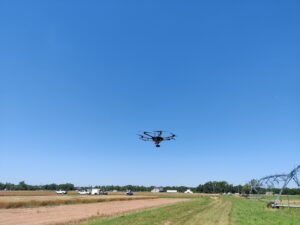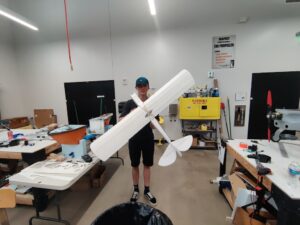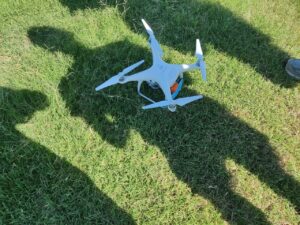Hello again! My name is Chris Pohorecki and this is a recap of my third week at my OSU Aerospace Engineering internship! As you may know from my previous posts, our group has been tasked with creating a bi-copter capable of VTOL flight and horizontal flight. Our concept will then be tested against a replica of NASA’s ingenuity, these tests include how large of an area each drone is capable of mapping out.
For our bi-copter’s camera my group decided upon a ready-made run cam capable of only taking video which we would then take stills from the video and stitch them together into a map. We chose this camera because it was incredibly light, took high-quality video, and the lab already had multiple of them! One problem with using stills from a video was that the photos aren’t geotagged making them very difficult to stitch together into a map as you would have no idea where the photo was taken. However, here at USRI we have access to a photogrammetry software that may be capable of stitching photos without geotags.
We then decided to test if the software would be capable of stitching a map together without any geo location. Using one of the available run cams we taped the camera on to an available drone and filmed a small area around the lab. After filming the area around the lab we took stills from the video and are now ready to test if the software will be capable of stitching the photos together. Sadly we won’t have access to the software until next week.

M600 drone flying over different species of wheat.
We were then taken on a small field trip to observe a photogrammetry mission to measure the results of an experiment carried out at a local farm to see the effectiveness of 300 different types of wheat. Using a m600 drone, a few undergraduate students flew over the wheat using a two different cameras they were able to capture a detailed map of the wheat in 5 different spectrums of light to monitor the growth of each species. This took about 20 minutes, a job that would otherwise take hours without a drone.
Onto to the next few days we began by learning, and practicing how to solder wires, boards, and connectors. Although I soldered before this, I now realize that I have been doing it wrong my whole life. This began by giving us an overview of what to look for in a good solder, and what a bad solder will look like. Different factors will cause solders joints to be strong or weak, such as temperature and the amount of solder. We then practiced by creating some JST connectors to a XT60, this process included crimping, heat shrinking, and different techniques of soldering.

A handsome man with a Simple Storch plane kit.
As we waited for our motors we began designing and printing prototypes of our thrust vectoring system and fuselage for our wing. We created our first design of the thrust vectoring system, after printing this design I quickly broke it by giving it a squeeze. We then created a second reinforced design that won’t brake to light pressure. Using an extra kit the lab had laying around, I built a large airplane similar to a cessna called the Simple Storch. We built this to use as a template to design and build a stronger wing. After assembling it, we stress tested different parts of the wing to see what would need improvement for our future design.
Throughout the week I spent time going out to eat with my roommates, and playing cards with each other. I look forward to spending the weekend with my father who has come to visit me this Sunday as we go to Oklahoma City. I look forward to my next week here in Stillwater Oklahoma!


There are no comments published yet.